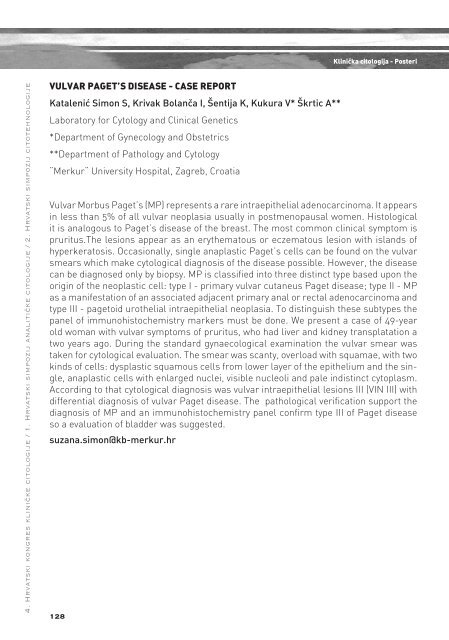4. Hrvatski kongres kliniËke citologije 4th Croatian Congress ... - Penta
4. Hrvatski kongres kliniËke citologije 4th Croatian Congress ... - Penta
4. Hrvatski kongres kliniËke citologije 4th Croatian Congress ... - Penta
You also want an ePaper? Increase the reach of your titles
YUMPU automatically turns print PDFs into web optimized ePapers that Google loves.
<strong>4.</strong> <strong>Hrvatski</strong> <strong>kongres</strong> <strong>kliniËke</strong> <strong>citologije</strong> / 1. <strong>Hrvatski</strong> simpozij analitiËke <strong>citologije</strong> / 2. <strong>Hrvatski</strong> simpozij citotehnologije<br />
VULVAR PAGET’S DISEASE - CASE REPORT<br />
Katalenić Simon S, Krivak Bolanča I, Šentija K, Kukura V* Škrtic A**<br />
Laboratory for Cytology and Clinical Genetics<br />
*Department of Gynecology and Obstetrics<br />
**Department of Pathology and Cytology<br />
“Merkur“ University Hospital, Zagreb, Croatia<br />
128<br />
Klinička citologija - Posteri<br />
Vulvar Morbus Paget’s (MP) represents a rare intraepithelial adenocarcinoma. It appears<br />
in less than 5% of all vulvar neoplasia usually in postmenopausal women. Histological<br />
it is analogous to Paget’s disease of the breast. The most common clinical symptom is<br />
pruritus.The lesions appear as an erythematous or eczematous lesion with islands of<br />
hyperkeratosis. Occasionally, single anaplastic Paget’s cells can be found on the vulvar<br />
smears which make cytological diagnosis of the disease possible. However, the disease<br />
can be diagnosed only by biopsy. MP is classified into three distinct type based upon the<br />
origin of the neoplastic cell: type I - primary vulvar cutaneus Paget disease; type II - MP<br />
as a manifestation of an associated adjacent primary anal or rectal adenocarcinoma and<br />
type III - pagetoid urothelial intraepithelial neoplasia. To distinguish these subtypes the<br />
panel of immunohistochemistry markers must be done. We present a case of 49-year<br />
old woman with vulvar symptoms of pruritus, who had liver and kidney transplatation a<br />
two years ago. During the standard gynaecological examination the vulvar smear was<br />
taken for cytological evaluation. The smear was scanty, overload with squamae, with two<br />
kinds of cells: dysplastic squamous cells from lower layer of the epithelium and the single,<br />
anaplastic cells with enlarged nuclei, visible nucleoli and pale indistinct cytoplasm.<br />
According to that cytological diagnosis was vulvar intraepithelial lesions III (VIN III) with<br />
differential diagnosis of vulvar Paget disease. The pathological verification support the<br />
diagnosis of MP and an immunohistochemistry panel confirm type III of Paget disease<br />
so a evaluation of bladder was suggested.<br />
suzana.simon@kb-merkur.hr


